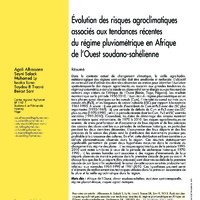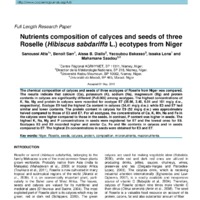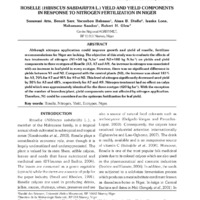Recherche
3 items
Evolution des risques agroclimatiques associés aux tendances récentes du régime pluviométrique en afrique de l’ouest soudano-sahélienne
Dans le contexte actuel de changement climatique, la veille agro-hydrométéorologique des regions semi-arides doit être ameliorée et renforcée. L’objectif de ce travail est d’utiliser des données observées en station pour identifier l’evolution spatio-temporelle des risques agroclimatiques associés aux grandes tendances du régime pluviométrique dans la bande soudano-sahélienne élargie aux parties Nord de certains pays côtiers de l’Afrique de l’Ouest (Benin, Togo, Nigeria). Les resultats montrent que sur la periode 1950-2010, l’evolution du regime pluviometrique est en trois phases quasi identiques sur les cumuls (Cum), l’intensite du cumul sur trois jours consecutifs (Px3), et les longueurs de saison culturale (LSC) par rapport a la normale 1961-1990. A savoir : i) une periode d’excedents de Cum et Px3 avec des LSC plus importantes (1950-1969) ; ii) une periode de deficits de Cum et Px3 avec des LSC plus courtes (1970-1990) ; et iii) la période récente dont les Cum, Px3 et LSC sont trés variables (1991-2010). Cependant, les dates de demarrage des saisons montrent une tendance quasi stationnaire, de 1970 a 2010. Les risques agroclimatiques de resemis, de stress post-floraison et d’occurrence de faux departs et de fins precoces des saisons des pluies sont lies aux periodes de secheresse historique, en particulier pendant les deux dernieres decennies. L’occurrence des faux departs et des fins precoces de la saison des pluies rend la distribution des evenements pluvieux peu profitable à la croissance des cultures
Nutrients composition of calyces and seeds of three Roselle (Hibiscus sabdariffa L.) ecotypes from Niger
The chemical composition of calyces and seeds of three ecotypes of Roselle from Niger was compared. The results indicate that calcium (Ca), potassium (K), sodium (Na), magnesium (Mg) and protein contents in calyces are significantly different (P<0.005) among ecotypes. The highest concentrations of K, Na, Mg and protein in calyces were recorded for ecotype E7 (35.66, 3.40, 6.01 and 101 mg/g d.w., respectively). Ecotype E9 had the highest Ca content in calyces (34.41 mg/g d.w.); while E3 and E7 had similar and lower contents. The protein content in calyces for E9 (52 mg/g d.w.) was approximately halved compared to those of E3 and E7. For all ecotypes, the concentrations of Ca, K, Mn, Na and Fe in the calyces were higher compared to those in the seeds. In contrast, P content was higher in seeds. The highest K, Na, Mg and P concentrations in seeds were registered for E7 and the lowest ones for E9. Ecotypes E3 and E9 recorded higher and similar Cu, Fe and Mn contents in calyces and in seeds compared to E7. The highest Zn concentrations in seeds were obtained for E3 and E7.
ROSELLE (HIBISCUS SABDARIFFA L.) YIELD AND YIELD COMPONENTS IN RESPONSE TO NITROGEN FERTILIZATION IN NIGER
Although nitrogen application could improve growth and yield of roselle, fertilizer recommendations for Niger are lacking. The objective of this study was to evaluate the effects of two treatments of nitrogen (N1=50 kg N,ha-1 and N2=100 kg N.ha-1) on yields and yield components in three ecotypes of Roselle (A3, A7 and A9). An increase in nitrogen was associated with an increase in leaf yield in every ecotype. However, there was no significant difference in yields between N1 and N2. Compared with the control plants (N0), the increase was about 181& for A3, 70& for A7 and 95& for A9 at N2. This level of nitrogen significantly decreased seed yield by 30& for A3 and 48&, respectively for A7 and A9. Nitrogen treatment had no effect on calyx yield which was approximately identical for the three ecotype (420 kg ha-1). With the exception of the number of branches/plant, yield components were not affected by nitrogen application. Therefore, N1 could be considered as the optimum fertilization for leaf yield.


